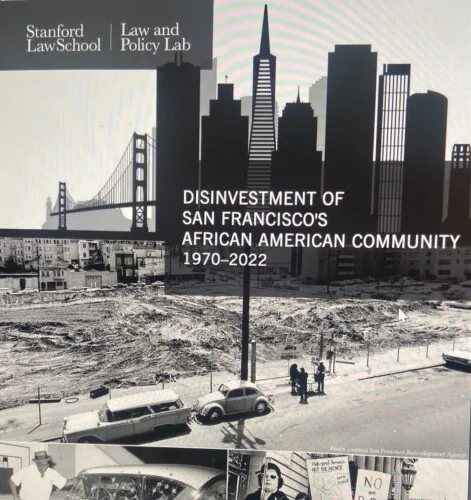Drawing on hundreds of sources and decades worth of data, students in a Stanford Law School Law & Policy Lab recently published a report that covers more than a half-century of the African American experience in San Francisco. Focusing on housing—namely the legal, social, and political restrictions that have prevented many Black residents of San Francisco from buying or owning a home–the report observes that the city’s Black residents have suffered not only well documented racism, but quantifiable economic harm in virtually all aspects of life.
A cross-disciplinary group of Stanford University and Stanford Law School students researched and drafted Disinvestment of San Francisco’s African American Community, 1970-2022 over the spring and fall quarters in 2022 through the Martin Daniel Gould Center for Conflict Resolution. The report then underwent almost a year of editing and pro bono input from attorneys at law firm Orrick before going to the client, the San Francisco Human Rights Commission (SFHRC) and its African American Reparations Advisory Committee (AARAC). The SFHRC provided the report to the San Francisco Board of Supervisors in March in connection with ongoing discussions around providing reparations to the city’s African American citizens. Janet Martinez, the then-director of the Gould Center; SLS lecturer Cary McClelland; and Gould research fellow Justin Bryant, JD ’21, oversaw the project.
While the report itself does not take a position on reparations, it provides a thorough historical examination of some of the relevant history for SFHRC, AARAC and others in San Francisco who are looking at the possibility of providing reparations to eligible African Americans in the city. The report sheds light on a host of other policy considerations and initiatives that the city could undertake to remedy past harms, Martinez says.

“What we lay out in the report is information that reflects real, concrete financial losses to residents of San Francisco, so you can look at the policy recommendations and say, ‘We need to find more ways to get African American teachers in our schools, we should have housing literacy classes, we should have more policies that we can enact now that will allow African Americans to live and thrive in this city,’” Martinez explains. Other policy suggestions in the report include creating African American cultural districts and arts communities, developing education curriculum that reflects African American history and culture, and establishing neighborhood clinics that address health care disparities.
Forcible Removal and Restrictive Covenants
The 227-page report charts the city’s role in creating and perpetuating racial segregation and discrimination. The SLS authors explored the continued impact of a host of city-led practices, past and present: discriminatory housing subsidies, zoning covenants, and the destruction of the Fillmore in the 1960s and ’70s to cite a few. According to the report, the demolition of the Fillmore, once called “the Harlem of the West,” was one of the worst periods of anti-Black city policies in San Francisco’s history. Redevelopment plans were carried out in two phases, forcibly removing families from their homes, destroying businesses, and displacing 20,000 to 30,000 San Franciscans. “The City’s official planning documents express the explicit intent to reduce the number of Black San Franciscans living in the city,” the report notes.
“As a Black person born and raised in the Bay Area, it was an amazing opportunity being able to work on this project,” says Brandon Roul, JD ’24, who focused primarily on researching the impact of racially restrictive covenants on Black San Franciscans.
“One neighborhood development that particularly stood out to me in my research was that of Lakeside where from 1939 to 1998, a covenant in the Lakeside Property Owners Association’s bylaws read: ‘No person other than one of the White Caucasian Race shall rent, lease, use or occupy any building on any lot in said tract.’” Roul says. “That covenant was only removed after San Francisco State Professor Mark Blank got the U.S Department of Housing and Urban Development to step in and reach an agreement with the Lakeside Property Owners Association after three years of unsuccessfully attempting to do it himself. Even though the U.S. Supreme Court held racially restrictive covenants unenforceable 50 years prior to the agreement, the Lakeside neighborhood is a blatant example of how systems of exclusion can continue to operate.”
Masha Miura, JD ’24, focused her research on issues around over-policing and mass criminalization, as well as the criminalization of homelessness through the use of the city’s nuisance laws. She says the experience of working on the report allowed her to “recapture some of the motivations that brought me to law school in the first place, including using my academic privilege in service of my communities.”

